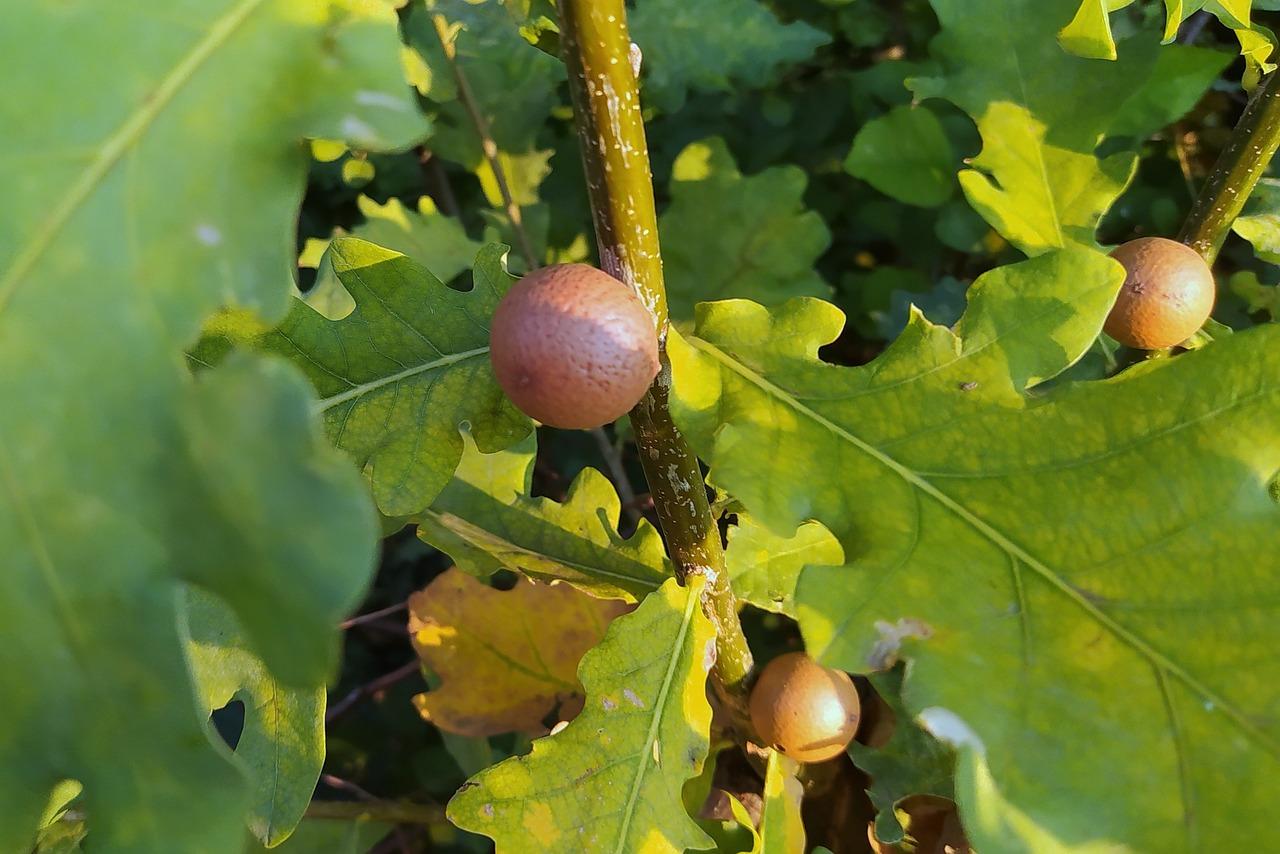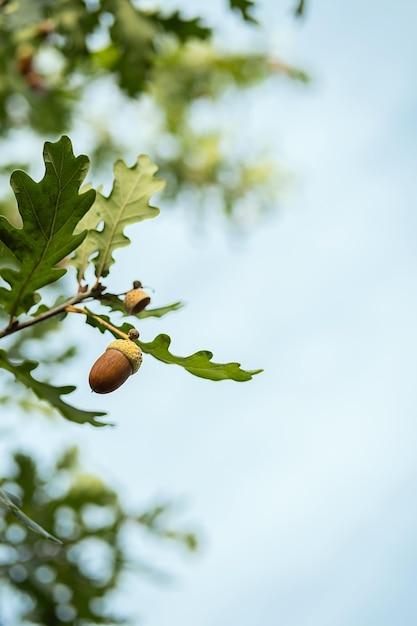If you’ve noticed mysterious white balls hanging from your oak tree, you’re not alone! These peculiar formations, known as oak galls, can often raise questions and spark curiosity. In this blog post, we’ll delve into the world of oak galls and explore their intriguing nature.
Oak galls are abnormal growths that develop on oak trees in response to the presence of certain insects, most commonly gall wasps. These small, hornet-like insects lay their eggs on the tree’s branches or leaves, causing a reaction in the plant tissue. As a result, the tree forms these distinctive ball-shaped galls, which serve as protective homes for the developing wasp larvae.
But what exactly do these galls mean for your oak tree? Are they harmful? Can they be beneficial? And what should you do if you spot them in your backyard? Stay tuned as we address these questions and more, providing you with a comprehensive understanding of oak galls and their impact on trees. So, let’s embark on this intriguing journey and unravel the secrets of the white balls adorning your oak tree.

What are Those Mysterious White Balls on My Oak Tree?
Have you ever wondered what those peculiar white balls hanging from your oak tree branches are? You’re not alone! These fluffy spheres can resemble tiny snowballs or perhaps an avant-garde art installation gone wrong. But fear not, dear tree enthusiast, as I will uncover the secrets behind these enigmatic objects.
A Closer Look at the Cotton Candy Balls
Upon closer inspection, you’ll realize that these delightful blobs are not actually made of sugary sweetness. Instead, they are formed by a fascinating creature called the oak gall wasp. These wasps are like tiny architects, utilizing the oak tree as their very own construction site. Talk about having an eye for real estate!
Galls: Nature’s Tree Decorators
Okay, but how do these wasps magically transform leaves into these fluffy ornaments? Well, the female gall wasp skillfully induces the oak tree’s tissue to grow into a protective structure, known as a gall. Think of it as a cozy, custom-made home for wasp larvae.
The Star of the Show: The Oak Gall Wasp
Meet the chief designer, the oak gall wasp, also known by its scientific name, Cynipidae. This cunning little wasp plays a critical role in the ecosystem, creating these galls as a safe environment for its eggs to develop and hatch. Talk about being resourceful!
Gall-Lore: A Peep into the Gall Life Cycle
Let’s dive into the fascinating life cycle of these wasps. The adult female wasp lays her eggs inside the developing gall, ensuring her offspring have a handy supply of food nearby. As the eggs hatch, the larvae feast on the gall’s nutritious tissues, growing and maturing within this cozy fortress.
The Circle of Life Continues
Once the larvae have completed their metamorphosis within the gall, they emerge as adults and continue the cycle. These gall wasps are like the Airbnb of the insect world, providing accommodation for future generations. Talk about being hospitable!
Why Should You Care About Gall Wasps
Now, you might be wondering, “Why should I care about these gall wasps?” Well, beyond their entertaining gall-formation skills, these wasps actually play a crucial role in the ecosystem. They help keep the oak tree population in check by pruning excessive growth. It’s like having nature’s own gardeners right in your backyard!
A Quirky Yet Essential Symbiotic Relationship
The relationship between gall wasps and oak trees is a true example of symbiosis. While the wasps benefit from the protective galls, the oak tree benefits by having its rampant growth curbed. It’s almost like a quirky partnership where both parties thrive.
Admire Nature’s Creations
Next time you spot these delightful white balls on your oak tree, take a moment to appreciate the intricate wonders of nature. These fluffy spheres are not just random ornaments; they are the result of a fascinating collaboration between tiny wasps and mighty oak trees.
So, let’s raise our imaginary glasses to the gall wasps, the oak tree decorators extraordinaire, and marvel at the undeniable creativity of the natural world!
Tags: oak tree, white balls, gall wasp, oak gall, nature, ecosystem

FAQ: What are the white balls on my oak tree?
Are oak tree galls poisonous to dogs
No, oak tree galls are generally not poisonous to dogs. However, it’s always a good idea to keep an eye on your furry friend and prevent them from ingesting large quantities of galls, as they may cause mild gastrointestinal upset.
What is oak gall used for
Oak galls have been used for various purposes throughout history. They have been used in the production of ink, dyes, and even as a medicinal remedy for certain ailments. However, in modern times, their uses are primarily limited to crafts and natural dyeing projects.
How do you get rid of fuzzy oak gall
If you’re dealing with fuzzy oak gall, the best course of action is to simply leave it be. While it may not be the most aesthetically pleasing sight, the fuzziness is caused by tiny insects called gall wasps. These wasps are actually beneficial for the ecosystem, so it’s best to let nature take its course.
How big can oak galls get
Oak galls can vary in size depending on the species of oak tree and the type of gall. Some galls can be as small as a pea, while others can grow to be the size of a golf ball.
What is inside a gall
Inside a gall, you’ll find a fascinating world of tiny insects, such as gall wasps, that use the gall as a protective home for their eggs and larvae. Galls also contain plant tissues formed in response to chemicals secreted by these insects, creating a unique structure.
How do you treat gall wasps on oak trees
Treating gall wasps on oak trees is not necessary, as the presence of galls is a natural and harmless occurrence. In fact, these galls provide shelter and nutrients for beneficial insects. So, instead of trying to eliminate them, embrace their presence as a sign of a healthy ecosystem.
Do squirrels eat oak galls
Squirrels have been known to nibble on oak galls occasionally, but they are not a significant part of their diet. These resourceful critters have a wide variety of food options in their environment, and galls are just one of many potential snacks.
Are gall wasps beneficial
Yes, gall wasps are beneficial insects. While they may cause the formation of galls on oak trees, these galls serve as protective homes for their eggs and larvae. Additionally, gall wasps play an important role in the ecosystem by controlling populations of other insect pests.
Why do oak trees have oak galls
The presence of oak galls on oak trees is the result of a fascinating relationship between the tree and gall-inducing insects, such as gall wasps. These insects inject chemicals into the tree that stimulate the growth of abnormal tissue, forming the distinctive galls we see.
Do galls harm oak trees
Galls generally do not harm oak trees. Although they may alter the appearance of the tree, they are typically not a cause for concern. In fact, galls are often a natural response by the tree to the presence of gall-inducing insects and can be seen as a sign of a healthy ecosystem.
Why are there wasps on my oak tree
If you notice wasps on your oak tree, it’s likely that they are gall wasps. These insects lay their eggs within the oak tree, resulting in the formation of galls. The presence of wasps indicates that the oak tree is providing a suitable environment for these beneficial insects.
Should I remove oak galls
There is no need to remove oak galls from your tree. Galls are a natural occurrence and do not pose any significant harm to the tree. In fact, removing galls may disrupt the ecosystem and prevent the beneficial insects from completing their life cycles.
What do oak gall wasps look like
Oak gall wasps are tiny insects, usually measuring less than half an inch in length. They can be yellow, brown, or black, and may have intricate patterns on their bodies. Although they may not be the most visually stunning creatures, their role in the ecosystem is invaluable.
Are oak galls the same as acorns
No, oak galls are not the same as acorns. Acorns are the fruit of oak trees, while galls are abnormal growths caused by insects. Galls have a distinct shape and often look like small balls or clusters attached to the tree’s branches or leaves.
What is the difference between a burl and a gall
A burl and a gall are both abnormal growths on trees, but they are caused by different factors. Galls are formed in response to insect activity, while burls are typically the result of a tree’s response to injury or stress. Burls have a rounded, woody appearance and are often prized for their unique grain patterns.
What are the white balls on my tree
The white balls on your oak tree are most likely oak galls. These galls are formed when gall-inducing insects inject chemicals into the tree, causing abnormal growth. The white color may be a result of the gall’s protective coating or the presence of fungus or mold.
Can gall wasps sting you
Gall wasps are not typically aggressive towards humans and do not pose a significant sting risk. These tiny insects primarily focus on their life cycles within the galls and are not known to be particularly interested in human interaction. So, you can rest easy without the fear of gall wasp stings.
What do you spray on oak galls
It is generally not necessary to spray anything on oak galls. As mentioned before, galls are harmless to the tree and provide a valuable habitat for beneficial insects. Pesticides or sprays could potentially harm these beneficial insects, so it’s best to let nature take its course.
Are galls bad for a tree
Galls are not considered harmful to oak trees. In fact, they are usually a natural and harmless response to insect activity. The tree may redirect resources to form the gall, but this does not cause significant damage or affect the overall health of the tree.
What does an oak tree gall look like
An oak tree gall can take on various shapes and sizes depending on the species of oak tree and the inducing insect. However, they often resemble small balls or clusters attached to the tree’s leaves or branches. Galls can have smooth or textured surfaces and come in a range of colors.
Can you eat oak apple gall
While some galls may have been used traditionally for medicinal purposes, it is generally not recommended to eat oak apple gall. Galls are primarily composed of plant tissue and the eggs or larvae of gall-inducing insects, which may not be appetizing or suitable for consumption.
How do you treat galls
Treatment for galls is not necessary, as they are harmless and serve as a part of the tree’s natural defense mechanism. Trying to remove or treat galls may disrupt the ecosystem and remove valuable habitats for beneficial insects. So, it’s best to simply leave them be and appreciate their role in nature.